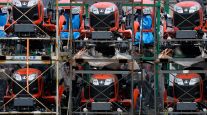Economy Stalls on Slump in Business Spending, Exports

The economy in the U.S. barely grew in the first quarter, buffeted by slumps in business investment and exports after oil prices plunged and the dollar surged.
Gross domestic product, the volume of all goods and services produced, rose at a 0.2% annualized rate after advancing 2.2% the prior quarter, Commerce Department data showed April 29 in Washington. The median forecast of 86 economists surveyed by Bloomberg News called for a 1% gain. Consumer spending, the biggest part of the economy, rose 1.9%, a little better than projected.
While the restraints of harsh winter weather and delays at West Coast ports were temporary, the effects of the drop in fuel prices and stronger currency will probably prove longer-lasting. Federal Reserve officials wrapping up their meeting later in the day may signal they’re in no rush to begin raising interest rates.
“Skepticism about the underlying health of the economy has developed in the face of soft data,” Stephen Stanley, chief economist at Amherst Pierpont Securities in Stamford, Connecticut, wrote before the report. He had forecast GDP would be little changed. The central bank “has promised to take the liftoff decision on a meeting-by-meeting basis beginning in June, but recent data make it unlikely that the Fed would actually raise rates quite so soon,” he said.
Economists’ forecasts in the Bloomberg survey ranged from little change in economic growth to a 1.5% gain. The GDP estimate is the first of three for the quarter, with the other releases scheduled for May and June when more information becomes available.
Corporate fixed investment decreased at a 2.5% annualized pace, the worst performance since the end of 2009. It grew at a 4.5% rate in the previous quarter.
Investment in nonresidential structures, including office buildings and factories, dropped 23.1%, the most in four years. It rose 5.9% in the prior quarter.
The decline reflected weakness in petroleum exploration as oil companies slashed budgets on the heels of plunging crude prices. Spending on wells and mines fell at a 48.7% annualized rate in the first three months of the year after an 8.1% gain at the end of 2014.
Machinery makers are suffering the brunt of the damage from slumping energy exploration, a stronger dollar and tepid overseas markets. Bookings for non-military capital goods excluding aircraft, a proxy for future corporate spending on new equipment, dropped in March for a seventh consecutive month, government figures showed last week.
Halliburton Co., the world’s second-biggest provider of oilfield services, said it expects to reduce capital spending by 15% this year and accelerated the pace of job cuts ahead of its takeover of Baker Hughes Inc.
The GDP report showed spending on equipment climbed 0.1% after a 0.6% gain in the prior three months.
The trade deficit swelled to an annualized $522.1 billion rate from $471.4 billion, as exports decreased and imports climbed. The gap subtracted 1.25 percentage points from growth, the most in a year.
Exports have fallen for four consecutive months as the dollar gained more than 20% since the end of June and overseas growth remains uneven. Whirlpool Corp., the largest maker of major appliances, on April 28 slashed its annual forecast, blaming currency fluctuations and sluggish demand in Brazil.
Spending by state and local government agencies was another soft spot, dropping at a 1.5% annualized rate, the most in three years. Federal outlays were also weak, rising at a 0.3% pace.
Consumer spending, which accounts for about 70% of the economy, grew at a 1.9% annualized rate, following a 4.4% jump from October to December that was the biggest since 2006. The median forecast in the Bloomberg survey was 1.7%. Purchases added 1.3 percentage points to growth.
One bright spot is automobile demand. Sales of cars and light trucks rose to a 17.05 million annualized rate in March from 16.2 million the previous month, according to Ward’s Automotive Group.
“Lower prices at the pump, improvements in employment, and overall positive consumer sentiment have driven greater demand for autos,” Thomas Szlosek, chief financial officer at Honeywell International Inc., said on an April 17 earnings call. The Morris Township, New Jersey-based company sees greater demand for its turbocharger technology as vehicle sales improve.
Households may be the best hope to drive a rebound in growth as the labor market improves and gasoline prices remain low. Disposable income adjusted for inflation climbed at a 6.2% annualized rate, the most in more than two years.
Because the gain in earnings exceeded the increase in purchases, the saving rate climbed to 5.5%, the highest since the end of 2012, from 4.6% in the fourth quarter.
The GDP report also showed price pressures remain limited. A measure of inflation, which is tied to consumer spending and strips out food and energy costs, climbed at a 0.9% annualized pace, the smallest gain since the end of 2010.
Economic growth may pick up to a 3.1% pace in the second quarter, according to the median forecast in a Bloomberg survey conducted April 3 to April 8. The median projection for 2015 is 2.9%.
The Fed’s long-awaited liftoff on its benchmark interest rate won’t happen until September, according to economists surveyed by Bloomberg, as officials try to spur inflation and hiring after the economy stumbled in the first quarter. Policy makers are due to release a statement later in the day.




